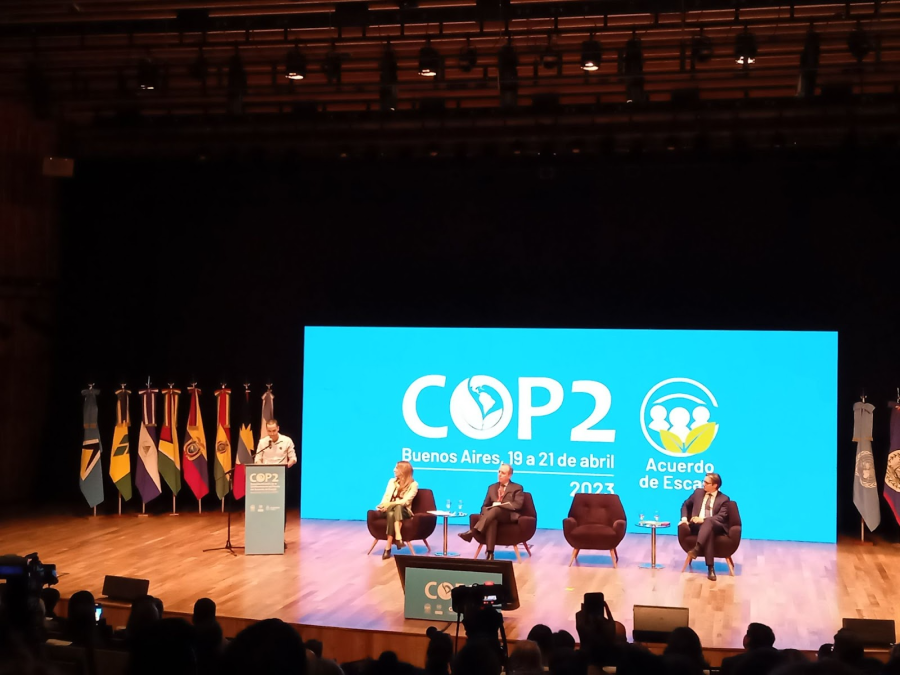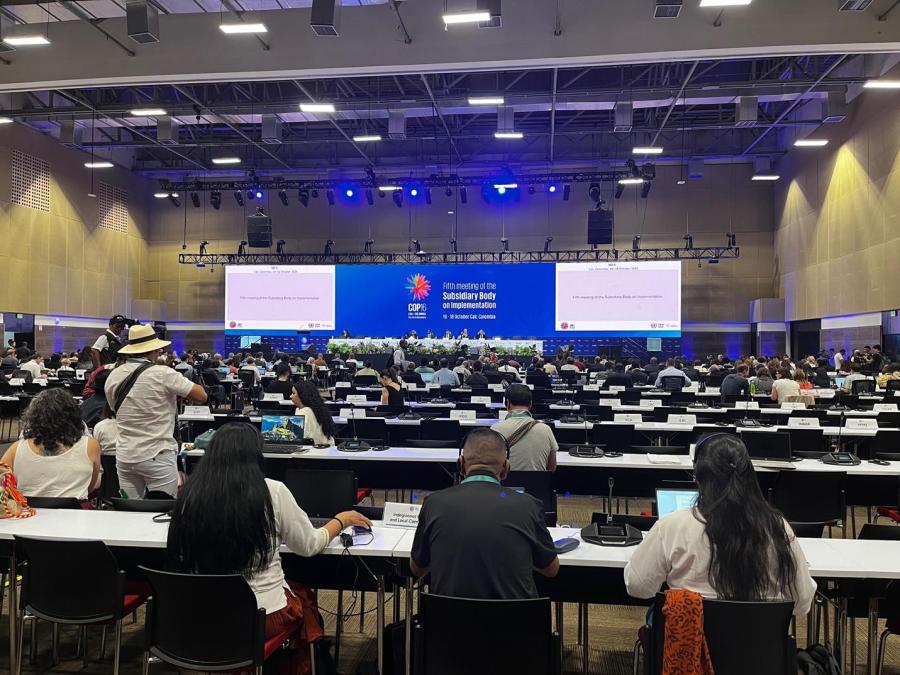In philanthropy, as in too many other areas, Indigenous Peoples tend to get scant attention. Despite being responsible for the majority of the world’s remaining biodiversity, and despite suffering the most egregious human rights violations and the highest rates of poverty, Indigenous programs receive less than one-fifth of one percent of U.S. foundation grants. And most of the grants they do get treat Indigenous Peoples as passive beneficiaries rather than as equal partners. But an organization called International Funders for Indigenous Peoples (IFIP) is working to change that model and is finding increasing success by having Indigenous representatives and foundation staff work together. To learn more about how this novel approach works, Cultural Survival’s Global Response director, Paula Palmer, interviewed IFIP’s executive director, Evelyn Arce, in June. Below are excerpts from that conversation.
Paula Palmer: How did you become involved in philanthropy?
Evelyn Arce: I started my journey in philanthropy by first working for First Nations Development Institute, a leader in giving to Native communities nationally. As a Colombian American of Chibcha descent, I was especially interested in a new project that the institute founded called International Funders for Indigenous Peoples (IFIP). I was asked to spearhead the project as a volunteer, which I did enthusiastically, and the project blossomed to the point that it demanded my full-time attention within only nine months. As I learned more about philanthropy and Indigenous Peoples, I became more and more consumed with the desire to make a difference, to bring Indigenous Philanthropy to the forefront of mainstream philanthropy. I was shocked at how little funding was going to Indigenous communities, especially international Indigenous communities, and I realized the power of education was critical in making a difference.
Everyone wants money, and there is lots of competition for it. How do you make the case for philanthropic giving to support Indigenous communities?
With the many global challenges that we are facing, Indigenous Peoples have models of resilience, sustainability, and adaptability that they can share with the world. Indigenous Peoples are known for being the best stewards of the most biologically diverse areas and have traditional knowledge that has been acquired over millennia.
Indigenous Peoples also contribute extensively to cultural diversity, enriching it with more than two-thirds of its languages, and yet language specialists predict that 90 percent of the worlds languages are likely to become extinct by the end of the century.
More and more donors are realizing that investing in the most effective, time-proven practices means investing in Indigenous communities.
It is really simply a matter of getting to know each other. There are a lot of stereotypes out there, of both philanthropists and Indigenous Peoples. Philanthropists think Indigenous cultures are too “exotic” to comply to Western standards of transparency and compliance. Indigenous peoples are wary of outsiders who claim to know better. But when they sit down, face to face, it becomes obvious that they actually have more in common than they thought. IFIP simply serves as a bridge between the two worlds: philanthropic and Indigenous. We provide intimate spaces for people to get to know each other. We say that IFIP is about “relationship philanthropy”: it’s all about taking the time to get to know each other.
All Indigenous cultures are based on reciprocity, which is the recognition of the symbiotic give-and-take they have observed in nature for millennia. So that is their understanding of philanthropy. To them, all parties are equal; otherwise, there is an imbalance, which is not the normal state of nature. We in the Western world think that capital symbolizes an equal exchange, but that symbolism is lost on Indigenous Peoples. Philanthropists need to understand that to most people in the world, the symbolism of cash is not a substitute for human effort.
This idea that they might need to do things a little differently is sometimes daunting to philanthropists. However, once they start to work with Indigenous Peoples, they quickly learn that transparency, trust, and compliance come naturally as part of the human interaction.
Are Indigenous Peoples receiving their fair share of funding given by foundations, family foundations, and individuals? How do you measure this?
Absolutely not! Indigenous communities are fighting a David and Goliath fight with little or no resources. The figures come from the Foundation Center, which compiles IRS reporting of over 70,000 U.S. foundations. It is very difficult, however, to know exactly how much of this money is going directly to Indigenous Peoples, since the reporting mechanisms do not capture all the grants, especially intermediary grants. We recently looked at international philanthropy for Indigenous Peoples and were shocked at how low the numbers were: less than a fifth of a percent.
Here are some stats:
Indigenous Peoples across six continents form the largest minority in the world, with more than 370 million people in more than ninety countries. In nearly every location, including in the United States, they are also among the most impoverished and underrepresented. This marginalization extends into the funding and research habits of the philanthropic community, where the amount of direct funding to Indigenous causes has not been tracked as closely as better-funded sectors of society. What is known is that of the approximately $27 billion in grantmaking by U.S.-based foundations in ’08, less than $55 million (0.2 percent) was earmarked for Indigenous causes and concerns internationally.
What are some of the obstacles in the way of getting needed funds into the hands of Indigenous communities?
From my experience, the top three are language and cultural differences, geographic isolation, and lack of a bureaucratic structure. There are over 5,000 Indigenous languages, and yet most funders require proposals in English. There is also a lack of access due to geographic isolation.
Indigenous Peoples are learning to adapt, but it has been a slow process, since there is not enough funding for technical assistance, which needs to be given concurrently with funding that addresses the immediate issues Indigenous Peoples face. They are standing at the frontlines to protect the world’s natural resources against oil, mining, and other megaprojects. They need to both build their bureaucratic and core capacity and receive immediate funding to support their struggles.
What is IFIP doing to address these obstacles?
Our role is largely as a cultural liaison, to bring two worlds together on common ground. We do this important work by using a two-pronged approach: education and advocacy.
IFIP provides a space for authentic exchange between donors and Indigenous representatives. We develop publications and offer a variety of opportunities for learning through our webinars, website, listserve, and meetings.
Our latest accomplishment is the New Grantmakers Guide to International Indigenous Philanthropy, which is the very first comprehensive report from interviews with dozens of funders that offers examples of successful projects and collaborations that came out of a little bit of creativity and flexibility. For instance, when some funders allowed Indigenous communities to submit video reports, videos that actually show where and how the funds were working, both sides won. The Indigenous Peoples enthusiastically learned a new communication tool, and the donors fulfilled their transparency requirements—and received ideal PR material with it! Now that’s true Indigenous reciprocity, otherwise known as a win-win situation, in our culture.
You’ve said your mission is to create a movement to transform philanthropy. How do you want to transform it?
Our mission is to create the tipping point, in which philanthropists recognize that Indigenous Peoples are natural partners in their work. Rather than being exotic, Indigenous Peoples are the most obvious people to work with.
The Intergovernmental Panel on Climate Change recently described Indigenous strategies to adapt to climate change more than 2,000 years ago. They called this ancestral knowledge “the way forward.”
That Indigenous knowledge was recognized by the official international scientific authority on climate change is a sign of the times. As more people become conscious of the interconnection of all people and all beings on the planet, acceptance of the spiritual sensibilities and earth-wisdom traditions of Indigenous Peoples will grow as well. Let’s just hope that these cultures still exist by the time that happens.
IFIP sees this growing consciousness as an opportunity to influence the tenor of the dialogue and the substance of increased funding for Indigenous causes. IFIP’s trademark is “walking the talk,” a brand of true authenticity that sits at the heart of Indigenous philanthropy.
It is during the direct exchange of ideas, especially at IFIP’s annual conferences, where so much learning takes place and so many funding opportunities take root. IFIP’s annual conferences involve more participants each year, including members and nonmembers. Printed publications reach 2,000 donors, Indigenous Peoples, and interested parties. Online versions of publications are downloaded by countless more. Participation in meetings and conventions held around the world advance IFIP’s presence and multiply its impact on the field of Indigenous philanthropy.
What will philanthropy look like when it is transformed?
Philanthropy will be as multinational as capitalism itself. It will be not only multicultural, but als multi-issue and multidimensional. Instead of, say, the environmental grant officer giving to one Mayan village in Guatemala, socio-environmental projects will fund social justice, economic development, and environmental defense across Central America, uniting peoples struggling against the same root causes.
Our vision is to have philanthropy transformed in a holistic way to truly effect deep change in the world, and we believe the core foundation is the 4 R’s of giving: reciprocity, respect, responsibility and relationship.



